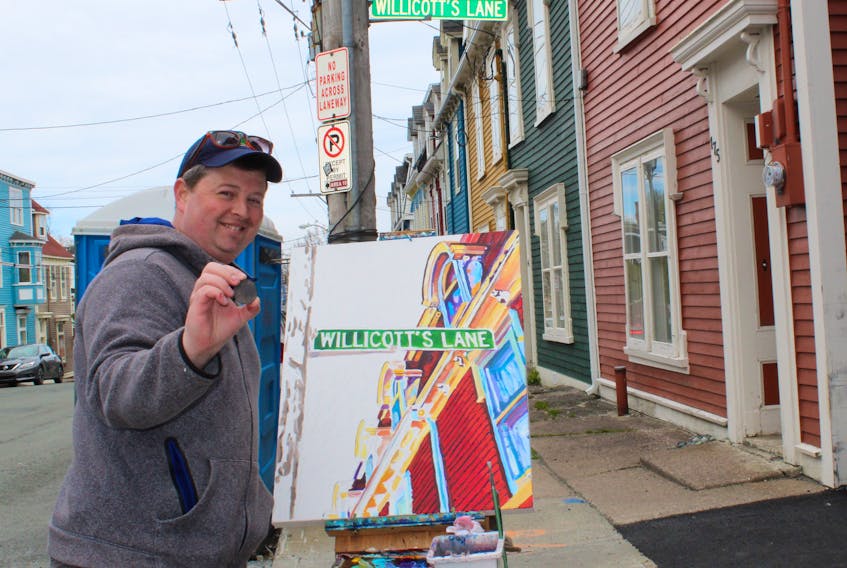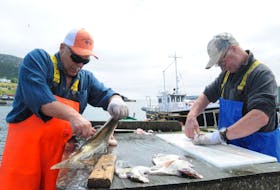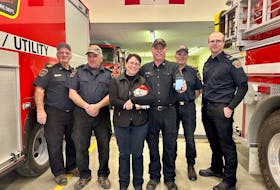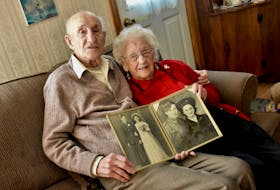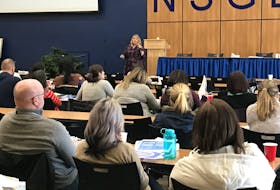ST. JOHN'S, N.L. — When Kevin-Barry Martin goes for a walk, he’s not only interested in exercising or spending time outdoors.
The 42-year-old St. John’s resident is part of a group called Newfoundland History Hunters, and he’s often on the move with his metal detector to find items of historical interest.
Last week while walking past a construction site, he found his latest artifact – a 220-year-old Spanish dollar.
On one side is the profile of Charles IV, King of Spain from 1788 to 1808. It’s dated 1799.
“Since beginning metal detecting, I’ve realized that there’s so much history underneath our feet – everywhere you walk,” said Martin, who is also an artist. While chatting with The Telegram about his recent discovery, he was in the midst of painting the streetscape where Gower Street meets Willicott’s Lane.

“Whenever I see a hole dug, I’m curious; I’ve got to look and see – is there anything sticking out of it?”
He believes it was Tuesday or Wednesday of last week when he noticed some piles of dirt near a construction site.
“I thought to myself, ‘Well, gee whiz, chances are there’s going to be something in that.’ I just figured I was going to find probably some old pennies, maybe an old Newfoundland penny or something like that.
“Anyways, it was just about to get dark – I was about to give up – and I got this signal, and I thought to myself, ‘Oh, it must be a piece of trash, an aluminum can.’ I turn over the little bit of soil that’s there and out rolled that big, huge Spanish coin.
“I had that Indiana Jones moment,” Martin laughed, “Even though it’s not really worth anything, you wouldn’t know but it was a million dollars.
“I was looking around,” he whispered: “‘Make sure nobody’s here,’ you know? The inner nerd,” he laughed.
Martin wouldn’t say exactly where he found the coin, but in the same pile of dirt he also found an enameled Star of David brooch and some Canadian pennies.
He believes the dug-up area is actually close to the original Waterford River.
“Where they had dug so deep, maybe they got down to that original riverbank. Because there was lots of broken glass and pottery and stuff like that because everybody back in the day… when they had trash, they wouldn’t go very far and they’d just throw it over a hill.”
St. John’s man finds 220-year-old Spanish coin in pile of dirt | The Telegram https://t.co/zknvScMbO4 @Pam_Frampton @LegendaryCoasts @sbradbury116 @StJohnsTelegram @NewFoundLand pic.twitter.com/qLeYScUN9z
— Kevin-barry martin (@Irishfun3) June 10, 2019
Spanish connection
Martin said he does his own research about the items he finds using the internet.
“If there’s anything of any question that we know, or we think might have some sort of historical significance, or is important, we always contact The Rooms.”
Most of the time, he said, “It’s nothing.”
“If there’s anything of any question that we know, or we think might have some sort of historical significance, or is important, we always contact The Rooms.” — Kevin-Barry Martin
The Telegram contacted archeologist Gerald Penney, whose company is monitoring the downtown water and sewer dig for historical artifacts, to see if he could provide further insight about the coin.
While he couldn’t speak about the artifact itself, he did speak more generally about the Spanish presence in St. John’s.
“In the earliest days of settlement in St. John’s there was Spanish and Basque and Portuguese fishing fleets here … but even that (coin) is a bit later than what I’m talking about. I’m talking about the 1600s and early 1700s. By 1799, the English had secured St. John’s and the Avalon.”
Still, he said there would have been Spanish ships coming and going in the harbour right up until after Confederation.
However, without a specific location to contextualize the coin, he said it’s difficult to say much more about it.
“Coins end up everywhere. It could have fallen out of someone’s pocket, who knows. … If there was a shop there, or a house or something, it could tell you more about it, but just a stray coin – it doesn’t tell you much, except you found a stray coin.”
Meanwhile, Martin said he’s had this hobby for six years and he’s yet to find the top item on his bucket list: a silver thimble.
“The thimble was something that was such a personal thing for any woman back in the day. They would use it every single day, and usually they would pass it on to a daughter, and so on. Women never really had anything to give to their daughters.
“It’s just such a personal item; I would love to find one.”
Twitter: @juanitamercer_
RELATED

